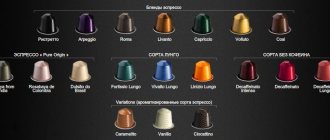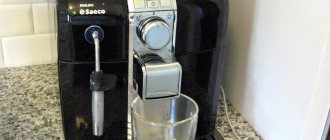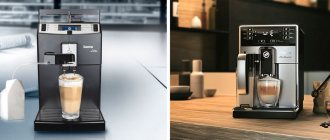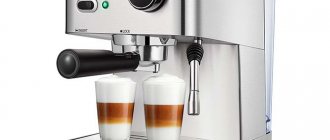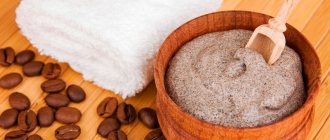How and from what does scale form?
We do not use sterile water for preparing food and drinks. Even filtered or bottled water contains a certain set of minerals. These include calcium, magnesium, iron. When water is heated, some of these minerals form an insoluble precipitate that remains at the points of contact between the heating elements and the water. Over time, sediment accumulates, the layers harden and form a crust. It's called scale. The more impurities in the water, the faster scale forms.
Scale can form in a coffee machine even from filtered or bottled water. The harder the water, the faster scale forms.
How often to do a decalcification program
It’s worth considering whether everything is okay with your device as soon as you notice that:
- the flow of the finished drink fades away;
- the foam ceases to be fluffy and thick;
- The resulting coffee turns out barely warm, and its delicate and pleasant taste deteriorates.
It might not hurt to clean the machine of oily coffee deposits and scale. After all, these factors negatively affect the heating and supply of the drink and even block the internal parts of the device.
So, in order to prevent this, we recommend removing formations at regular intervals, the frequency of which depends on the degree of hardness of the water consumed.
Reference. To find out what level of water hardness you have, do a test. Take a special test strip and dip it in the liquid. The degree of color will indicate the concentration of calcium in the water.
There are options for coffee machines with automatic detection of water hardness level. For them, it is enough to specify the parameter once in the coffee machine menu, and the program will remember it. However, in the absence of instructions, the machine will operate at the factory setting. That is, you will have to clean the device after each boiler containing 30 liters of water is poured.
When the water hardness level is within normal limits, the coffee device will require cleaning only after using 120-240 liters of water.
The conclusion follows from this: so that the coffee machine does not require descaling ahead of time, it must be adjusted in accordance with the actual degree of water hardness. The harder the water used to prepare the drink, the more often the device should signal the advisability of descaling.
It is important for coffee machine users to monitor the quality of the prepared drinks and even wash them ahead of time if necessary. A simple way to recognize when cleaning is due is the presence of white sediment in the mug.
What is decalcification of a coffee machine?
The basic element of scale is calcium salts. They have a loose, porous structure and easily add other elements from the water: iron, magnesium, potassium, fluorine. Decalcification is the removal of mineral plaque by softening the calcium crust. It is impossible to scrape off plaque by mechanical means. Rough intervention is dangerous as it can damage the heating elements of the coffee machine.
Therefore, decalcification is carried out using special means that react chemically with calcium salts. As a result, the crust softens, crumbles and is easily removed with water. Modern industry produces ready-made products to combat plaque. Some coffee machine owners prefer traditional, low-cost life hacks that help deal with this problem.
Why is decalcification necessary or why is scale dangerous?
Limescale in a coffee machine is dangerous both for equipment and for humans. Deposits cause problems with the heating element. In a coffee machine it is very small, so even minor interference will interfere with its effectiveness. The scale forms a kind of coupling around the heating element, interfering with heat transfer. The result is a double negative effect.
- The heating element overheats and can burn out from excess heat
- The coffee water is not hot enough.
Insufficiently heated water does not do a good job of brewing coffee; the drink turns out sour, weak and cloudy due to underextraction.
Repair shops will tell you cases where not only heating elements, but also the entire body of the coffee machine suffered due to limescale deposits. Over time, lime corrodes fastening and connecting elements.
How else is scale dangerous?
- Blockage of the water passage in the system.
- Blocking the tap through which coffee flows into the cup.
- Getting into a cup of coffee.
- The proliferation of bacteria that thrive in the loose structure of limescale.
Decalcification extends the life of the coffee machine and allows you to prepare tasty and safe coffee.
When should decalcification be carried out?
The timing of the decalcification procedure is indicated in the instructions for the coffee machine. Automatic coffee makers can themselves report the need for a procedure. You should not think that the machine evaluates the state of the water and its elements. It is programmed to decalcify after a certain number of cups of coffee are prepared. All machines are designed for use with hard water.
If your machine is not equipped with reminder functions, and the instructions do not contain anything about decalcification periods, then rely on the following recommendations from service specialists.
- If you only use bottled water, you can decalcify once every 10-12 months.
- If you use filtered water, then decalcification should be done every 6-8 months.
- If your area has hard water and you use a filter, then decalcification should be done after 4-6 months.
- If your area has hard water and you do not use a filter, then decalcification should be carried out every 3-4 months.
Indirect signs of the need for decalcification may include:
- musty smell of coffee;
- increased machine noise;
- foreign impurities in coffee.
Cleaning with decalcifiers
All manufacturers of household appliances recommend using descaling products offered by the same company to descale your coffee machine. This is indicated in any instructions. However, all products are created using the same technology and have a similar composition. They are available in both liquid and tablet form:
- Not everyone can afford to clean a coffee machine using DeLonghi Branded products are of high quality and guarantee excellent results.
- Cleaning a coffee machine with Saeco descaling agent is cheaper, but it is almost as good in terms of quality.
- Other companies offer their own cleaning products to care for household appliances.
DeLonghi
Saeco
Coffee machine decalcifiers
There are many means for decalcifying a coffee machine, which can be divided into specialized and popular ones.
Specialized decalcification products
Specialized preparations for decalcification are produced in the form of liquid and tablets.
Liquids are sold in bottles for 1-2 uses. Many manufacturers of coffee equipment prescribe in their instructions the use of only branded products of the corresponding brand: Bosch or Saeco.
There are multi-brand liquids for universal use, for example, Top House or Filtero.
The compositions of all products use the same active substances, so it is quite possible to use any universal product for decalcification.
Tablet preparations differ in the form of release and the concentration of active substances. One or two tablets are usually enough to clean the coffee machine. Tablet products are cheaper than liquid ones.
Folk remedies for cleaning coffee machines
These include citric acid. An acidic environment softens calcium deposits well. The acid is diluted at the rate of 10 g per 1 liter of water and the resulting solution is used.
Citric acid is inferior in effectiveness to specialized products. Some experts consider it too aggressive for the heating element and the body of the coffee machine. The use of citric acid can damage the protective coating of heating elements and they will begin to rust.
No other types of acids can be used for decalcification, not even the popular acetic or oxalic acids. They are too aggressive for the internal structure of the coffee machine.
Methods for decalcifying a heating element
If you read the article before all these problems arise, they can be prevented. Just take the instructions for your device. It describes in detail all points of the process. The simpler the coffee machine, the more sequences, the more complex the technique, the shorter the process becomes. Instructions for decalcifying a coffee machine are your lifesaver. It would be unnecessary to describe the entire sequence here, since each device has its own. If the instructions are lost or you are tasked with cleaning office equipment, you have several options:
- Find a manual online. To do this, you need to enter the full name of the coffee machine, get the manual, find in it the item “Methods of care and cleaning” or something similar. Large manufacturers such as Delonghi or Jura can print everything you need on their websites.
- Invite your device into your home or send it to a service center, where experienced technicians will clean it for you. In this case, you need to remember - you will pay not only for the liquid or cleaning tablets, but for the work.
Manual cleaning
The third point is to try to perform standard manipulations with the coffee maker. You might be lucky - it won't get worse, it might just not work.
- Fill the reservoir with water, add the product to the liquid in a certain proportion, which is indicated on the bottle.
- Turn on the machine, make coffee without coffee.
- Wash the tank, fill it with clean water, repeat the process several times in the absence of coffee.
- Dry the coffee machine.
Real coffee
It’s easy to check how clean your coffee maker is - try making one of your favorite drinks. If everything is in order, you win.
There are tablets for decalcifying coffee machines. In most coffee makers the process goes like this.
- The tablet is placed in the bean receiver.
- Water is poured into the reservoir.
- The “ground coffee” process starts.
- Coffee preparation begins without the presence of beans.
- After the process is completed, it is necessary to clean the cake compartment from tablet remnants.
- Fill the reservoir with water and repeat without coffee to rinse the machine.
If your technique refuses to “cook” the tablet, you will have to trick the machine. This can be done by dissolving the product in water and loading the grains. This “coffee” will have to be thrown away.
Squesito capsule coffee machine
How to descale a coffee machine?
Automatic coffee machines in the high price segment have special cleaning programs. You need to pour liquid descaling agent into the machine and run it in the desired program. If you are using tablets, the drug must be diluted in water according to the instructions and, after complete dissolution, the tablets must be used in the same way as a liquid product.
In some models, a special program is not provided and cleaning is performed in a sequence of actions. The entire procedure is described in the instructions for the coffee machine.
Semi-automatic and many automatic coffee makers are cleaned by simply running the coffee program. Do not add grains; instead of water, add cleaning liquid or a tablet diluted in water. The resulting “drink” is immediately poured out and the procedure is repeated with plain clean water, without any means.
The decalcification procedure is always described in the instructions for the coffee machine. Therefore, strictly adhere to the sequence of actions. The only place where deviation is appropriate is the choice of means. You can take a generic one rather than a branded one, or replace the liquid with tablets.
How is manual cleaning done?
How to descale a coffee maker manually? Everything is quite simple, the main thing is to study all the actions that need to be performed during this process. If you do everything correctly, then all important elements (capsules, horn, container) will be completely cleared of limescale.
Cleansing begins by pouring water into the water container.
Let's look at the step-by-step process of descaling a coffee maker:
- First you need to choose a descaling cleaner for your coffee machine. You should first study its properties, composition, and features of use. The instructions indicate the rules of use that must be followed;
- you need to remove the water filter;
- You need to pour 1-1.5 liters of clean water into the water container;
- then a special cleaner is added, and its required dosage must be observed;
- the device must be turned on, 100-150 ml of liquid must be drained;
- The device must operate in cooking mode for 5 minutes. The machine turns off, up to half a liter of water and cleaner are drained from it;
- then the device turns on again. The same steps are repeated until all the liquid has been drained;
- Clean water is poured into the apparatus. The whole same dream procedure is repeated once;
- Rinse the water container thoroughly. At this stage it is important to completely remove all scale;
- the water filter is washed with detergent, rinsed and installed in place;
- After this, you can start preparing a tasty and aromatic coffee drink.
How much does decalcification and refusal cost?
The most painful issue is financial. Many people think that decalcification is too expensive. Let's do the math.
- 800-1200 rubles for a bottle of branded cleaning liquid. It is enough for 1-2 uses.
- 150 to 500 rubles per bottle of a universal product.
- 200-450 rubles per pack of tablets, one tablet – one cleaning cycle.
We find that the cost of a cleaning “session” ranges from 50 to 600 rubles.
How much does it cost to not descale your coffee machine?
A burnt heating element will lead to replacement of the boiler, and this costs from 8-10 thousand without transportation costs.
